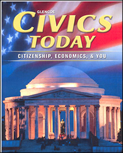
Civics Today Citizenship, Economics, & YouChapter 26: Comparing Economic SystemsChapter OverviewsInternational trade is one of the major forces in the world today. Because of trade, people can enjoy goods that are not produced in their own country. Countries also trade with one another because of comparative advantage. This is the ability of a country to produce a good at a lower opportunity cost than another country. Trade also creates jobs. Sometimes governments impose barriers to trade in order to protect domestic industries. Some barriers to trade are tariffs and quotas. In other cases, countries join together to create free trade zones. Many nations in Europe have joined together to create the European Union (EU). The United States, Canada, and Mexico signed the North American Free Trade Agreement (NAFTA). Not all economic systems are alike. The United States and many of the other largest economies in the world are market economies. Others, like Cuba and North Korea, have command economies. In a command economy the government tells producers what to do. Most countries of the world have a mixed economy, which combines basic elements of a pure market economy and a command economy. In the 1980s, some countries with command economies began to make changes. The nations of Eastern Europe and Russia began to shift from command economies to market economies. This has been a very difficult transition. China is also moving toward a market economy. |  |















